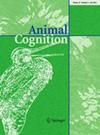Pictorial depth cues elicit the perception of tridimensionality in dogs
Abstract
The perception of tridimensionality is elicited by binocular disparity, motion parallax, and monocular or pictorial cues. The perception of tridimensionality arising from pictorial cues has been investigated in several non-human animal species. Although dogs can use and discriminate bidimensional images, to date there is no evidence of dogs’ ability to perceive tridimensionality in pictures and/or through pictorial cues. The aim of the present study was to assess the perception of tridimensionality in dogs elicited by two pictorial cues: linear perspective and shading. Thirty-two dogs were presented with a tridimensional stimulus (i.e., a ball) rolling onto a planar surface until eventually falling into a hole (control condition) or until reaching and rolling over an illusory hole (test condition). The illusory hole corresponded to the bidimensional pictorial representation of the real hole, in which the pictorial cues of shading and linear perspective created the impression of tridimensionality. In a violation of expectation paradigm, dogs showed a longer looking time at the scene in which the unexpected situation of a ball rolling over an illusory hole occurred. The surprise reaction observed in the test condition suggests that the pictorial cues of shading and linear perspective in the bidimensional image of the hole were able to elicit the perception of tridimensionality in dogs.


 求助内容:
求助内容: 应助结果提醒方式:
应助结果提醒方式:


